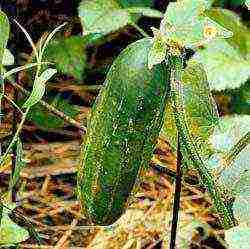Content
The list of varieties of vegetables and other important crops that were zoned and recommended for cultivation in the Stavropol Territory according to the reference book for 1967, as well as the regions of the Republic of Karachay-Cherkessia.Stavropol region
Zones of the region and distribution by zones of administrative districtsI. Northeastern... Districts: Apanasenkovskiy, Arzgirskiy (without the Serafimovskiy state farm), Ipatovskiy (northeastern part), Kurskiy (northeastern part), Levokumskiy and Neftekumskiy.
II. Eastern... Districts: Arzgirsky (state farm "Serafimovsky"), Blagodarnensky, Izobilnensky (northern part), Ipatovsky (southwestern part), Krasnogvardeisky, Kursky (southwestern part), Petrovsky, Prikumsky, Sovetsky and Shpakovsky (state farms: named after Kirov, " Grachevsky "and the collective farm" Zarya ").
III. Central... Districts: Aleksandrovsky, Georgievsky (without the collective farm "40 years of October"), Izobilnensky (southern part), Kochubeevsky, Mineralovodsky (without state farms: named after Karl Marx, "Caucasus" and konzavod No. 169), Novoaleksandrovsky, Shpakovsky (without state farms: named after Kirov , "Grachevsky", collective farm "Zarya") and the city of Stavropol,
IV. Foothill... Districts: Georgievsky (collective farm "40 years of October"), Mineralovodsky (state farms: named after Karl Marx, "Caucasus", stud farm No. 169), Predgorny (northern part), the cities of Pyatigorsk, Zheleznovodsk, Yessentuki, Lermontovsky and areas of the Karachay-Cherkess Autonomous Region - Adyge-Khablsky, Karachaevsky (state farm "Krasnogorsky"), Malokarachaevsky (state farms "Krasnovostochny" and "Eltarkach"), Prikubansky, Khabezsky and the city of Cherkessk.
V. Mountain... Districts: Foothill (southern part), Kislovodsk and districts of the Karachay-Cherkess Autonomous Region: Zelenchuksky, Karachaevsky (without the Krasnogorsky state farm), Malokarachaevsky (without the Krasnovostochny and Eltarkach state farms), and Urupsky.
Varietal zoning by crops
Winter wheat... Zones I and II: mid-early - Bezostaya I, For sowing on unpaired predecessors - Priazovskaya; without primary seed production - mid-season - Odessa 16. Zone III: a) for Aleksandrovsky district - mid-early - Bezostaya 1; without primary seed production - mid-season - Odessa 16; b) for other areas of the zone - mid-early - Bezostaya 1. Zones IV and V: mid-early - Bezostaya 1. When irrigated. Zones II and III: medium early - awnless 1.
Winter barley. Along the edge: Beta 40; without primary seed production - Red Gift.
Oats... Along the edge: Artyomovskiy 107; without primary seed production Soviet.
Spring barley... Zones I and II: South. Zone III: Southern, Valticki. Zones IV and V: Walticki.
Millet... Zones I and II: Saratov 853, Veselopodolyanskoe 367. Zone III: Veselopodolyanskoe 367; without primary seed production - Saratov 853. Zones IV and V: Veselopodolyanskoe 367.
Buckwheat... Zone III, IV and V: Bogatyr.
Rice... For rice cultivation areas: early maturing - Dubovskiy 129; mid-late - Krasnodar 424.
Peas... Along the edge: Ramonsky 77, Voronezh, admit to sowing for 1967 - Uladovsky 303.
Beans... Zone II: Triumph. Zones III, IV and V: Krasnodar 19305.
Chyna... Zones I, II and III: Steppe 287 Steppe 12. Zone IV Steppe 287.
Chickpea... Zones I, II and III: State Farm.
Sunflower... Zones II, III, IV and V: Leader.
Soy. Along the edge: VNIISK 1; in addition, for zone III - Kuban 4958.
Mustard... Zones I and II: Non-sprinkling 2, Volgogradskaya 189/191.
Oil flax... Zone I: Stavropol 79. Zones II and III; Large-seeded 3, Stavropol 79. Zone IV: Large-seeded 3.
Castor oil plant... Along the edge: VNIIMK 165, Early hybrid; for irrigation - Donskaya 39/44.
Coriander... For coriander growing areas: Ray.
Sugar beet... For areas of sugar beet cultivation: Yaltushkovsky hybrid, Ramonskaya 06.
Hemp... For hemp growing areas: Krasnodar monoecious 3, Nevinnomysskaya.
Potato... Zone I: for spring and summer plantings - early maturing - Epron; mid-season - Majestic (crustacean); for summer landings - Krepysh. Zone II: for spring and summer plantings - early maturing - Epron, Ulyanovskiy; mid-season - Majestic, for summer plantings - Krepysh. Zone III: for spring and summer plantings early maturing - Ulyanovsk; mid-early - Volzhanin; mid-season - Majestic, Krepysh. Zone IV: for spring and summer plantings - early maturing - Ulyanovsk; mid-season - Strong. Zone V: for spring plantings - early maturing - Ulyanovsk; mid-early - Volzhanin, Lyubimets (cancer-resistant); mid-season - Strong; mid-late - Lorkh.
White cabbage... Zones I and II: early ripening - No. 1 Gribovskiy 147; mid-early - Golden hectare 1432; mid-season - Slava Gribovskaya 231; mid-late - Braunschweigskaya 423, Krasnodarskaya 1, Gift; late ripening - Amager 611, Zimovka 1474, Biryuchekutskaya 138. Zone III: early ripening - Number one Gribovskiy 147; mid-early - Golden hectare 1432; mid-season - Slava Gribovskaya 231; mid-late - Autumn Gribovskaya 320, Krasnodarskaya 1, Gift; late ripening - Biryuchekutskaya 138, Zimovka 1474, Amager 611. Zone IV and V: early ripening - Number one Gribovskiy 147; mid-early - Golden hectare 1432; mid-season - Slava Gribovskaya 231; mid-late - Braunschweigskaya 423, Krasnodarskaya 1, Gift; late ripening - Biryuchekutskaya 138, Zimovka 1474, Amager 611; in addition, for zone IV - mid-season - Slava 1305. Along the edge: for the canning industry - Number one Gribovskiy 147, Slava Gribovskaya 231, Slava 1305, Krasnodarskaya 1.
Red cabbage... Along the edge: Gako.
Cauliflower... Along the edge: Patriotic.
Salad... Along the edge: Ice Mountain.
Spinach... Along the edge: Victoria.
Sorrel... Along the edge: Belleville.
Cucumbers... Along the edge: Grouse 357/4, Donskoy 175, Biryuchekutsky 193; for the canning industry - local Nezhinsky.
Tomatoes... Zones I, II and III: Moldavian early, Donskoy 202, Volgogradsky 5/95. Zones IV and V: Early Moldavian, Voskhod 119, Krasny Dar, Volgograd 5/95. For the canning industry. Along the edge: Cannery standard, Pervenets 190, Krasnodarets 87 / 23-9.
Onions on a turnip... Along the edge: annual seed culture - Lugansk, Krasnodar G-35, Kaba, Strigunovskiy local; two-year culture from sevka - local Strigunovsky; for the canning industry - Kaba, Strigunovsky local.
Bow on a green feather... Along the edge: batun, chives.
Onions - forcing culture... Along the edge: shallots - Kuban yellow D-322.
Garlic on the edge: Dungan local and other best local varieties.
Table carrot... Along the edge: Nantes 4, Incomparable; for the canning industry - Nantes 4, Chantenay 2461.
Table beet... Along the edge: Donskaya flat 367, Bordeaux 237; for the canning industry - Bordeaux 237.
Radish... Edge: Winter round black.
Parsley... Along the edge: Harvest.
Radish... Along the edge: Ruby, Rose red with a white tip.
Sugar peas... Zone IV: Inexhaustible 195, Zhegalova 112.
Shelling peas... Zone IV: Miracle of Calvedon 1378, Winner G-33.
Vegetable beans... Along the edge: Saxon without fiber 615, Green-handled 517; in addition, for zone IV - Shrub without fiber 85; for the canning industry - Zelenodruchnaya 527.
Sugar corn... Along the Edge: Fairy Tale 435.
Sweet pepper... On the edge: Novocherkassky 35; in addition, for zones II, III and IV - Large yellow 903; for the IV zone - Maikop 470. For the canning industry - Bulgarian 79.
Hot pepper... Along the edge: Astrakhan 147, Giant.
Eggplant... Along the edge: Donskoy 14, Delicatessen 163; for the canning industry - Long purple 239.
Watermelon... Zones I and II: Bykovsky 22, Melitopolsky 142, Dessertny 83, Favorite farm of Pyatigorsk 286, Bagaevsky goosebump 747/749. Zone III: Melitopolsky 142, Favorite of Pyatigorsk farm 286, Bagaevsky goosebump 747/749, Dessertny 83. Zone IV: Favorite of Pyatigorsk farm 286, Bagaevsky goosebump 747/749.
Melons. Zone I: Kolkhoz Woman 749/753, Wintering with apple seeds.Zone II: Kolkhoz Woman 749/753, Komsomolskaya Pravda 142, Wintering with apple seeds. Zone III: Bykovskaya 735, Kolkhoz Woman 749/753. Zone IV: Kolkhoz Woman 749/753, Bykovskaya 735, Novelty of the Kuban. Zone V: Kolkhoz Woman 749/753.
Pumpkin... Zones I and II: Volga gray 92. Zones IV and V: Mozoleevskaya 47.
Zucchini... Along the edge: Gribovskie 37.
Corn for grain. On the bogar. Zones I, II, III and IV: mid-season - hybrid VIR 42 (VIR 42M, VIR 42MV). Zone III: mid-late - hybrid Krasnodar 309 (Krasnodar 309T). Zone V: mid-early - hybrid Bukovinsky 3 (Bukovinsky ZTV).
With irrigation. Along the edge: middle late - hybrid Krasnodar 309 (Krasnodar ZO9T); late ripening - hybrid Dnieper 90T.
For seed production with the aim of exporting seeds to other regions of the USSR: mid-early - hybrid Bukovinsky 3 (Bukovinsky ZTV); mid-late - Krasnodar 1/49, Sterling; with irrigation late ripening - Odessa 10.
For the needs of trade and food industry enterprises - mid-season - Rice 216; in addition, for zones IV and V - mid-early - Siliceous white local. For silage. On dry land: Along the edge - mid-season - hybrid VIR 42 (VIR 42M, VIR 42MB); in addition, zones I, II, III and IV - middle late - Krasnodar 1/49. Zones II, III, IV: middle late - hybrid Krasnodar 309 (Krasnodar 309T). Zones III, IV and V: late ripening - hybrid Dnieper 90T. Zones II, III and IV: late-ripening - Odessa 10. When irrigated: Along the edge: mid-late - hybrid Krasnodar 309 (Krasnodar 309T); late ripening - hybrid Dnieper 90T.
Sorghum for grain... Zone I: Hegari. Zone II: Sugar 28/435, Kubanskoe 1438. Zone III: Kubanskoe 1438.
Sorghum broom... Zone II: Venichnoe 623.
Winter rye for green fodder and silage. Along the edge: Burunnaya.
Winter vetch... Zones III and IV: Pannonian.
Spring vetch... Zones IV and V: Lgovskaya 31-292.
Peas for feed (pelushka). Zones II, III and IV: Southern (Kazakhstan).
Broad beans... Zone V: Uladovsky violet.
Sudanese grass... Zones I, II, III and IV: Krasnodar 1967, Chernomorka.
Panic. Zones I, II, III and IV: Dnepropetrovsk 31.
Sorghum for silage... Zone I: Red amber; for irrigation - Chinese amber 813. Zone II: Red amber, Sugar 28/435, Orange 450. Zones III and IV: Red amber.
Alfalfa... Zones I and II: Manychskaya. Zone III: Slavic local Manych. Zone IV: Slavic local. On the edge; the best local varieties.
Clover... Zones IV and V: Circassian local.
Sainfoin... On the edge: North Caucasian two-mow.
Timofeevka... Zones IV and V: Ossetian 1.
Zhitnyak... Zone I: Krasnokutsky narrow-spiked 305. Zone II: Krasnokutsky wide-spiked 4, Krasnokutsky narrow-spiked 305.
Bonfire straight... Zone III: Krasnodar 8.
Fodder carrots... Along the edge: Guérande, Incomparable; in addition, for - I and II zones - Chantenay 2461.
Fodder beet... Along the edge: Eckendorf yellow, Semi-sugar white.
Fodder watermelons... On the edge: Brodsky 37-42, Dishim.
Fodder pumpkin... Zones I, II and III: Large-fruited 1; in addition, for the III zone - Vitamin.
Mulberry... Along the edge: Kharkovskaya 3.
Zoning of silkworm hybridsIn silkworm breeding areas. For spring industrial feedings - hybrids: Early maturing 2 X Belokonnaya 2 and Belokonnaya 2 X Early maturing 2, PS-5 X Early maturing 2 and Early maturing 2 X PS-5. For summer industrial feedings - hybrids: Early maturing 2 X Belokonnaya 2 and Belokonnaya 2 X Early maturing 2; Early maturing 2 X PS-5 and PS-5 X Early maturing 2.
Vegetables
On the eve ofII All-Russian Conference "Grain Caucasus", head Department of Breeding, Seed Production and Storage Technology of Plant Production. Professor F.I.Bobryshev of the Stavropol State Agrarian University, Alexander Voiskovoy tells the portal's correspondentabout new varieties of winter wheat bred in the Stavropol Territory.
- Alexander Ivanovich, Ph.What are the regional peculiarities of growing grain crops in your area? What are the risks? And what work is being done to optimize them?
- Let's start by recalling the geographical location of our region, which creates unique conditions for growing cereals. The Stavropol Territory is located in the southern part of the European territory of Russia. The area of the region is 66.2 thousand square meters. km. The region has a wide variety of agro-climatic conditions from an extremely arid zone in the east to a zone of sufficient moisture in the south.Therefore, the main focus of the crop industry is the cultivation of grain crops, of which winter wheat is the most valuable food crop.
The main risks in the cultivation of winter cereals include worsening weather conditions, such as in the 2011-2012 agricultural year. According to the data of the State Scientific Institution "Stavropol Research Institute of Agriculture", the autumn vegetation of winter crops was one month shorter than in recent years, plants on a larger area of crops went into winter in the phase of 2-3 leaves, without forming additional shoots and a secondary root system. November was characterized by cold weather. The termination of the vegetation of plants occurred on November 6-7. Sharp cold snaps were noted at the end of the first, middle of the second and in the third decades of November. In the conditions of the Stavropol Territory, the main cause of plant death is freezing. Extremely low temperatures in January-February 2012 had a negative impact on the condition of winter cereals.
The main way to optimize existing risks is the selection of adaptive varieties of grain crops.
— Your department of breeding, seed production and storage technology of crop production is engaged in the study and development of ways to increase yield. Please tell us more about your developments?
- Agricultural technology plays an important role in increasing the yield of winter wheat grain. But the yield itself is largely determined by the hereditary economic and biological properties of the varieties. Replacing old varieties with new ones provides an increase in yield by 10-40%. New varieties pay off the costs of their cultivation better, since they use fertilizers, plant protection products from pests, diseases and weeds more efficiently. According to the Ministry of Agriculture of the Stavropol Territory, the Federal State Budgetary Institution "State Commission of the Russian Federation for Testing and Protection of Breeding Achievements" in the Stavropol Territory, the State Public Institution "Stavropol Agricultural Information and Consulting Center" in 2011 more than 120 varieties of winter wheat were cultivated in the region.
Our analysis of the yield of winter wheat varieties in three soil-climatic zones (in 2005-2011) for two predecessors (pure fallow and winter wheat) showed that for pure fallow the share of climatic conditions in the formation of the yield is 63%, and the contribution varieties - 21%. The interaction of factors cultivar-environment is 11%.
- Alexander Ivanovich, bplease tell me how they gostate variety testing of new varieties of winter wheat FIB, Bosmina, Bagryanitsa? Are these varieties bred by your department? What makes them different?
- In recent years, we have bred 2 varieties of winter soft wheat FIB and Bosmina and 1 variety of winter durum wheat Bagryanitsa. Employees of the Stavropol State Agrarian University have been breeding for several years to create high-yielding varieties of winter soft and durum wheat with high quality products, resistant to environmental stress factors based on innovative breeding methods.
Since 2009, the FIB winter wheat variety has been undergoing State variety testing in the North Caucasus and Lower Volga climatic regions. A variety of erythrospermum. According to the results of a competitive inter-station test with an average grain yield of 58-64 c / ha, the increase in comparison with the Don 95 standard was 10-12%. In terms of quality, grain of the FIB variety belongs to the group of strong wheat with a high content of crude gluten and protein. This variety is resistant to fungal leaf diseases such as brown and yellow rust, powdery mildew. It is also drought-resistant and its winter hardiness is above average. The FIB variety is distinguished by its salt tolerance, which makes it competitive when grown in the solonetzic soils of the Stavropol Territory and the South of Russia.
The Bosmina variety was transferred in 2010 for the State variety testing in the North Caucasian climatic region.A variety of it is erythrospermum and it is resistant to lodging. According to the results of a competitive inter-station test with an average grain yield of 50-55 c / ha, the increase in comparison with Ivin's standard was 7-10%. The Bosmina variety stably forms grains of 1-2 class, with a high content of crude gluten and protein. This variety is also resistant to fungal leaf diseases: brown and yellow rust, powdery mildew. Winter hardiness is above average. The Bosmina variety is drought-resistant and has a high salt tolerance, it recommended for cultivation in solonetzic soils of the Stavropol Territory and the South of Russia.
The Bagryanitsa variety has also been undergoing State variety testing for the North Caucasian climatic region since 2010. A variety of italicum. Plant height is average. According to the results of a competitive inter-station test, the average grain yield of 51-54 c / ha, the increase in grain yield in comparison with the Prikumskaya 124 standard was 7-10%. In terms of quality, the Bagryanitsa grain belongs to the first class, with a high glassiness, content of crude gluten and protein. It has excellent pasta qualities. Resistant to fungal leaf diseases: brown rust, powdery mildew, Drought-resistant. Winter hardiness at the standard level. Here is a brief summary of the varieties that our department is currently dealing with.
- Alexander Ivanovich, let me ask the following question. In recent years, Russia has taken a leading position among grain exporters, but the quality of grain is rather low. What is the reason? What are the dangers of the current trend in your opinion? How to improve grain quality? What methods are there? And are they applied in the Stavropol Territory?
- For many years, the Stavropol Territory has been one of the largest producers of commercial grain of winter wheat. This is due to the fact that the soil and climatic conditions of most regions are relatively favorable for the production of grain of strong and valuable wheat with high technological properties.
Stavropol wheat has always been famous for its high quality. If we analyze the results of the survey, starting from 1965, the following trend is observed. 1976-90. agricultural enterprises of the region carried out the necessary agrotechnical measures to improve the quality of grown winter wheat, which made it possible to annually produce strong and valuable wheat (second and third classes) 86-92% with a gluten content of 25-36%.
The production of high-quality wheat grain in the region was facilitated by the improvement of the structure of sown areas. Winter wheat was placed in pairs and good predecessors, organic and mineral fertilizers were applied under them, top dressing was carried out, diseases, pests and weeds were fought.
Beginning in 1991, the gluten content in grain began to decline sharply, and there were practically no strong wheats even in 1995-1996. food wheat production was only 32.2% and 44.9%, respectively. The average gluten content in 1995 was only 15%, the lowest in a 48-year period.
Since 2002, there has been a tendency to increase yields from 30.0 (in 2002) to 40 c / ha (in 2008), as well as growing more food wheat. So for the period 2002-2010. 78-86.0% of food wheat was identified, with the 3rd class - 25.8 ... 51%, 4th class - 31 ... 51.0%. However, the average grain quality remains low, the average gluten content ranges from 19.0 to 22.0%, protein from 11.4 to 12.5%.
Specialists of the Stavropol branch of the Federal State Institution “Center for Evaluation of the Safety and Quality of Grain and Its Processing Products” and the staff of the department have practically not revealed strong wheat, although there are great opportunities for growing high-quality wheat in the region. The grain producers of the region need to return the previously conquered heights.This can be done by selecting varieties that can form high-quality grain, observing fruit-changing crop rotations, introducing perennial grasses and legumes into crop rotations, introducing optimal doses of mineral fertilizers and feeding with nitrogen at certain stages of organogenesis.
- A hDoes your department engage in cost analysis in the production of grain crops? Which of the stages of grain production is the most expensive?
- On the basis of scientific research and practical development, it is known that the main determining costs in the production of grain are: an exorbitant rise in prices for fuels and lubricants, fertilizers, plant protection products. The most costly work is the main soil cultivation, crop care, harvesting work and measures for additional processing, cleaning and storage of grain.
— In a market environment, production profitability is paramount. What are the ways to improve profitability today?
The main way to increase the profitability of grain production is to obtain a stable harvest of high quality grain, a favorable pricing policy and government support for agricultural producers.
- Alexander Ivanovich, in Pyatigorsk May 22 will host the II All-Russian Conference "Grain Caucasus". What questions do you advise to pay attention to?
- I would draw the attention of the conference participants to a number of issues. First, that it is necessary to eliminate the price disparity between the cost of agricultural products and the cost of agricultural machinery, fertilizers, protective equipment, fuels and lubricants.
Also, due to the "staff shortage" in the agro-industrial complex, it is necessary to create favorable conditions for workers in the agrarian sector, i.e. improve social conditions of life, increase wages, create conditions for compliance with safety regulations.
In my opinion, it is necessary to increase state support for carrying out research work aimed at selection work, the development of new technologies for the cultivation and storage of grain.
Source
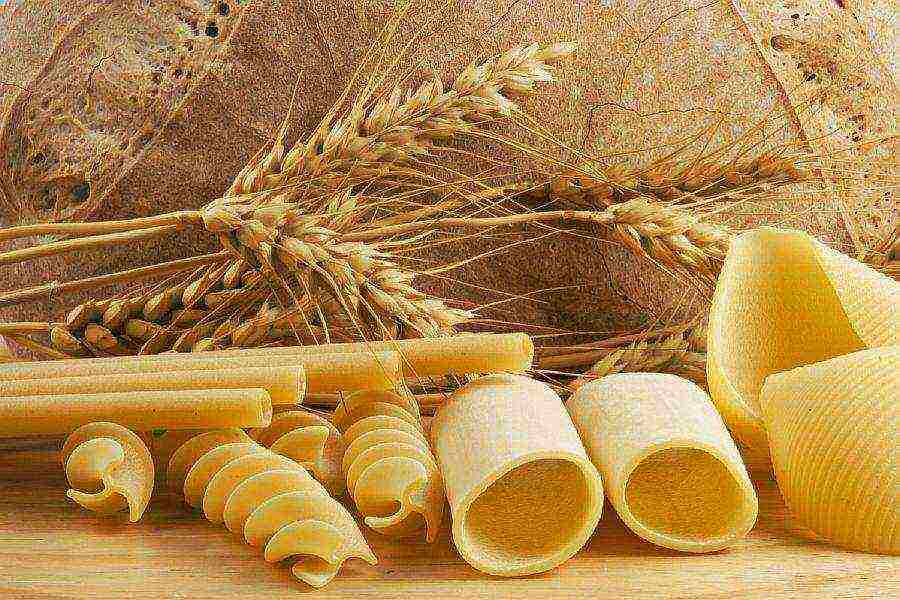
Why do farmers neglect durum wheat?
Did you know that the lion's share of pasta produced in our country cannot be called pasta? The overwhelming majority of them are made from soft wheat flour. That is, from the same flour that is used to bake bread. As a rule, such pasta is boiled during cooking, losing its beneficial properties. And it is they that cause excess weight in those who often use them. Only durum wheat flour can be used for real pasta. When grinding it, a special pasta grits are obtained. It is from her that they make full-fledged pasta. After boiling, they retain their shape and excellent taste.
Battle of the breeders
Durum wheat varieties in the Stavropol Territory ceased to be cultivated back in the 30s of the last century. The reason, at first glance, is serious. The varieties of wheat available to agronomists were low-yielding. They could not compete with soft winter wheat varieties. By the way, varieties of winter durum wheat did not exist biologically in nature in those years. True, in the 50s of the last century, attempts were made in the region to resume the production of spring durum wheat. But it was not possible to turn the tide. The region was still forced to import flour for the production of pasta from other regions.
Stavropol agronomists-breeders, of course, could not put up with this state of affairs. They made another attempt to breed winter durum wheat by hybridization. And many years of work have been crowned with success. In the fields of the region, the durum wheat variety "Prikumchanka", bred at the Prikumskaya Experimental Breeding Station, was zoned. Unfortunately, the area under it grew extremely slowly. But in favorable years, the variety produced 50 quintals of grain per hectare.The grain of this wheat is not only not inferior in its quality characteristics to other similar varieties, but even surpasses them. It is no coincidence that the farms of the Saratov region willingly bought seeds of the "Kumchanka" plant from the station and tried to expand the sown area under it.
In subsequent years, breeders from Budennovsk create several more varieties of winter durum wheat. The varieties "Prikumskaya-142" and "Steppe Amber" are included in the State Register of Breeding Achievements of the Russian Federation. According to station director Nikolay MorozovBoth varieties are wonderful, in dry years they give 40 or more centners of grain per hectare, and in favorable years the harvest reaches 65 centners. And the quality of the grain is excellent.
As for the pasta qualities of flour, the state commission rated them with the highest score. The high adaptability of the same "Kumchanka" to different soil and climatic conditions is evidenced by the fact that at one time the variety was the only one that was recommended by the state commission for sowing not only in the republics of the North Caucasus, but also in the fields of the Volga region, from where Stavropol for many decades imported flour for pasta.
The reasons are commonplace
Today, very small areas are occupied by durum wheat varieties. So, for the production of pasta and confectionery products, we will again import wheat from other regions? Where are you going to go? There is, however, a second option - to make pasta from soft wheat. Which, however, is what many are doing today. Only such products cannot be called pasta. For some reason, in the understanding of Europeans, only durum wheat flour can be used for the production of pasta. In Italy and France, there is even a corresponding law.
It seems that the agrarians of the Stavropol Territory are somewhat dismissive of the cultivation of durum wheat. Did she deserve this attitude? Annually allotting up to two million hectares of arable land for grain crops and growing 7-8 million tons of grain each, the region, nevertheless, is forced to import flour for the production of pasta from other regions of the country. As explained Alexey Abaldov, leading specialist of the Stavropol Agricultural Information and Consulting Center, the reason for this situation is the most commonplace. Manufacturers seek to reduce the cost of their products using soft wheat varieties. Until recently, prices for wheat were the same - what kind of soft varieties, what kind of hard ones. This is a clear bias, it should not be so. Secondly, there is little information about new varieties. Many heads of farms and agronomists, of course, have heard about “Prikumskaya-142” or “steppe amber”. But not everyone knows that these are durum wheat varieties. Meanwhile, the "steppe amber" in the fields of the Prikumskaya experimental station provided a yield of 64.5 centners per hectare in two years. The variety is of a low-growing type, with increased resistance to drought and sawfly.
But today the mistake has been corrected, the purchase prices for high-quality grain of durum wheat are 1.5-2 thousand rubles per ton higher than for grain of soft wheat. Specialists of the Prikumskaya Experimental Breeding Station believe that the varieties of durum wheat they have developed feel good in the eastern zone of the region. Nikolai Morozov, in particular, emphasized that the selection of durum wheat is carried out in harsh climatic conditions. It has been noticed, for example, that the less precipitation, the higher the quality of the grain. By the way, the scientists of the Prikumskaya station managed to develop one more variety of durum wheat, it was named "gum". Nikolai Morozov said briefly about him: he is better than the previous ones.
Nikolay SHEBALKOV
Photo
BY THE WAY
It is curious that back in the 19th century, Italy was willingly buying Stavropol durum wheat. In a number of cities of this country, pasta was sold by shops with an unusual sign - "Arzgir". This word was to some extent a Russian quality mark in those years. But then our country lost this glory.

Wheat is a popular cereal crop that is grown in many countries of the world with favorable climatic conditions. Russia is no exception. Cereal grains are used for grinding into flour, after which it is used to prepare various products (baked goods, pasta, etc.). There are more than 300,000 varieties of wheat, and every year their number only increases. Breeders are developing new forms that are highly resistant to various diseases and have significant yields. What is the average yield, where is grain production in Russia widespread and what varieties are common, you should understand in more detail.
Main growing regions
Grain production in Russia is possible in almost all regions. The main advantage of any type of cereal is its picky to weather conditions. The main cultivation areas are the Stavropol and Krasnodar Territories. In these territories, grain harvest reaches almost a quarter of the total state harvest and has a higher yield.

Good yields are also observed in other areas:
- Volgograd.
- Saratov.
- Omsk.
- Kursk.
- Voronezh.
- Altai Territory.
Each of the regions provides 3-5% of the total amount collected throughout the country. A significant wheat harvest in Russia can be traced in the Belgorod and Penza regions. Here, wheat production in Russia is at a high level, while some northern regions are completely unsuitable for growing such crops.
Modern crops
Russia is a northern country with a cool climate for growing grain crops. But even with these difficulties, you can find ways to optimize production.
Grain plays an important role in the economy of the Russian Federation. The state is distinguished by higher yields than most tropical countries, therefore it exports the product in large volumes.
Since the 2000s, wheat production per hectare has increased sharply. The authorities decided to sow almost half of all sown area allocated for grain. In 2006, more than 60% of all cereal fields were already filled with this crop.
In post-war times, NS Khrushchev decided to make corn the second bread in the country. In the 1950s and 1960s, corn was planted en masse, but throughout the Khrushchev government, wheat held the leading position.
Almost 70 years have passed and the current Russian government says that Khrushchev's strategy was successful. The yield of corn is much higher - it is less nutritious and healthy product. It can be actively used as feed for domestic animals, which could contribute to the development of agriculture and animal husbandry.
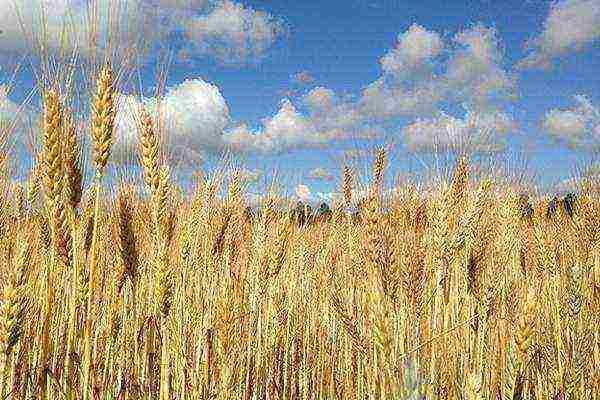
In 2016, the scale of wheat planted areas in Russia was 27704 thousand hectares, and this is almost 59% of all fields allocated for grain crops.
How many centners per hectare are harvested of wheat: it is almost impossible to answer unequivocally. It depends on soil, climatic conditions and other factors.
Varieties of culture
Wheat varieties are grown on the territory of Russia:
- spring;
- winter;
- soft varieties;
- hard varieties;
- dwarf, etc.
Hard varieties are not grown very actively. Such varieties do not show high yields. The grown durum wheat is more often used to make good pasta. The ear of such a culture is distinguished by its dense structure and long awns. Large volumes of durum wheat from warmer countries are annually imported to Russia, as it is in demand among consumers and is of high quality.
Soft varieties are much more common - the grain is used for baking bread. Flour is great for making confectionery. There are no bones here at all. The seed has a rounded shape.
Dwarf varieties are rarely grown, but most confectioners claim that this flour is best for baking cakes, pastries, cookies, etc.
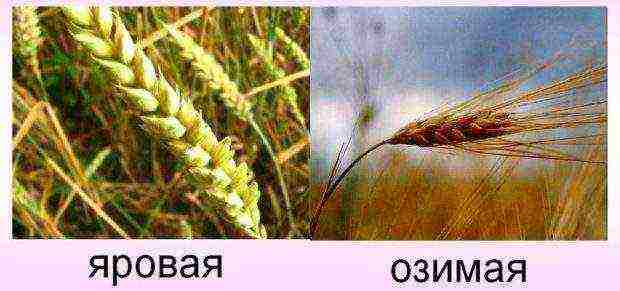
The technological map of the cultivation of spring crops suggests that it is better to plant it in the spring and harvest it in the fall.
Where to grow spring wheat on the territory of the Russian Federation: this is the most picky variety that takes root in almost all regions of Russia.
The main thing is to follow some spring wheat cultivation procedures in order to get a good harvest, the table of requirements of which is known to everyone who is engaged in crop cultivation.
Winter wheat is sown in late autumn or winter. The advantage lies in the fact that in the spring it receives useful substances along with melt water. Thanks to early sprouting, the crop is less weedy. This is demonstrated by the record grain harvest.
Grain collection in the USSR by years
The volume of wheat cultivated in the USSR was categorically lacking, so imports flourished. Exports also accounted for 8% in the 60s, and later - only 0.5%. Imports, on the other hand, grew literally every day and, as a result, exceeded 20%. The yield by republic is presented in the table below.
| Year | Production, tons |
| 1961 | 62 494 000 |
| 1965 | 56 105 008 |
| 1970 | 93 750 000 |
| 1975 | 62 250 000 |
| 1980 | 92 500 000 |
| 1985 | 73 200 000 |
| 1990 | 101 888 496 |
| 1991 | 71 991 008 |
There is an opinion that in the USSR they grew grains of 3-5 classes, and bought high-quality wheat of 1-2 classes. There is no confirmation of this, but since the 70s, the USSR began to buy wheat several times less than to export - this trend continues to this day.
Production in Russia by years
Based on statistical compilations of the Federal State Statistics Service, it is easy to analyze the dynamics of wheat production from 1 ha / ton in Russia over the years:
- 1992 — 46,2;
- 2000 — 34,5;
- 2005 — 47,5;
- 2008 — 67,8;
- 2009 — 61,7;
- 2010 — 41,5;
- 2011 — 56,2;
- 2015 — 56,7;
- 2017 — 57,2.
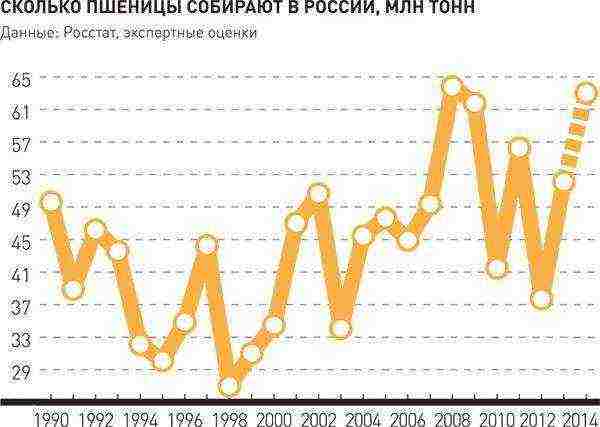
The base growth rate is 112.8%. Today wheat production has increased by 12.8%. The main reason why such changes have taken place is that the structure of demand in the domestic and foreign markets has changed, and also the selling prices are strikingly different.
Productivity by region
Wheat production as of 2017 allows us to consider the development trend by region. The main producing region is the Rostov region - 9,031.3 thousand tons. The share in the total fees is 11.9%. The Krasnodar Territory is also not inferior - collections here amount to 8,957,000 tons. The third place went to the Stavropol Territory - 7 713 thousand tons. The Volgograd region collects 3 353.4 000 tons with 4.4% of the total collection for the year. Altai Territory - 2,977.8. Saratov region at the level of 2 795.1 thousand tons. Omsk takes the honorable seventh place in grain production and produces 2,568.4 thousand tons. Voronezh and Kursk regions in the range of 2299.7-2493.4 thousand tons. The Republic of Tatarstan ranks 10th in the rating of regions with collections of 2,142.6 thousand tons.
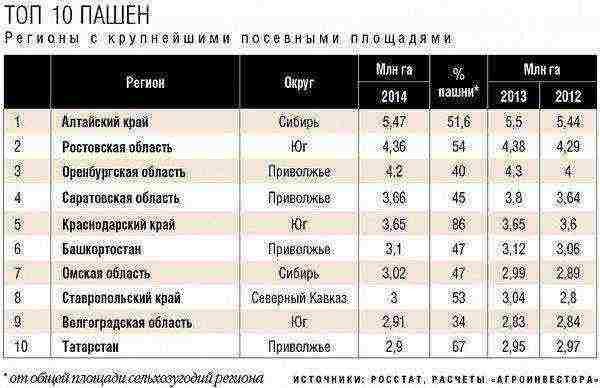
The top 20 in terms of gross receipts includes the following regions:
- Orenburg region - 2073.8.
- Orlovskaya - 1883.5.
- Tambov - 1877.0.
- Lipetsk - 1791.3.
- Krasnodar Territory - 1745.0.
- Novosibirsk region - 1631.6.
- Bashkortostan - 1576.1.
- Kurgan region - 1565.9.
- Penza region - 1392.6.
- Belgorodskaya - 1381.6.
All other regions not included in the top 20 produced 14,547.2 thousand tons of wheat.
Russia is a large grain trader that supplies many countries of the world with the most essential varieties for baking bakery products. Even despite the large harvest, the Russian Federation imports durum wheat for the manufacture of high-quality pasta.
In some areas, climatic conditions do not correspond to normal indicators for the growth and development of wheat and other grain crops, therefore, genetically modified products are often used in such areas. This does not mean that only Russia produces such crops. Most of the world leaders in grain production also use this practice. Now you know where wheat grows, which varieties are most common, and what they are used for.
